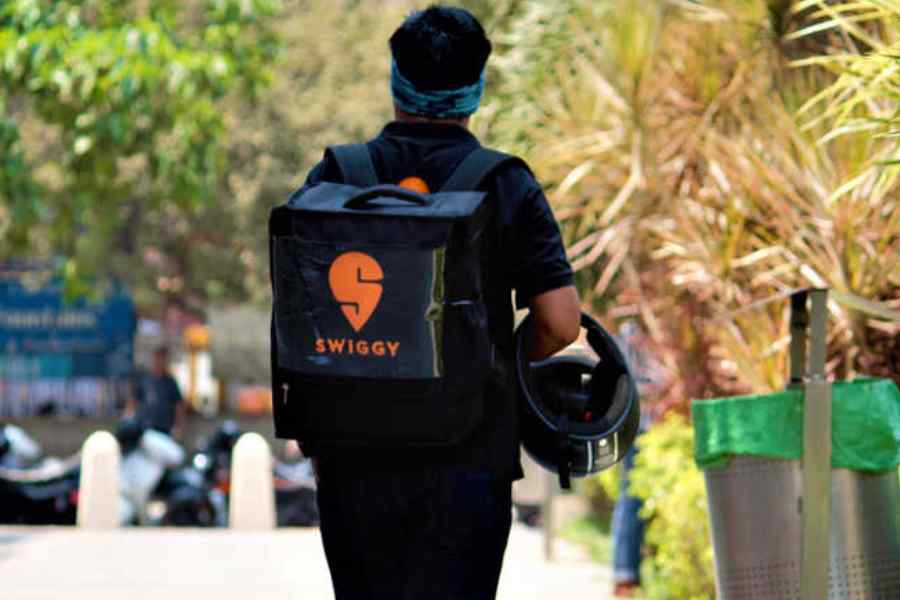 |
| A Palash tree in bloom in Malda town. Picture by Surajit Roy |
Farzana Bibi from Nadanghat, Putul Mali from Srirampur and Ganesh Karfa from Lakshmipur, have all recently brought back home blank reports from a water testing centre. Since the reports said the water could not be tested, they threw away the meaningless pieces of paper. But they could not get rid of their fear.
Between 3,500 and 4,000 people are suspected to be suffering from arsenicosis in these two blocks of Burdwan, but they cannot get the water that carries the poison tested.
Villagers are tense in Purbasthali blocks I and II, where the amount of arsenic in water is thought to be five times the permissible level or even more, but the water cannot be examined because the authorised test centres have not been sent supplies of the chemical necessary to test arsenic in the water.
The chemical, silver diethyldithiocarbamate (SDDC), has not been supplied to the six test centres in the district authorised to conduct arsenic tests, in Burdwan town, Nadanghat, Ghuskara, Kusumgram, Ketugram and Kalanabagram, for six months.
“The levels of iron and chlorine in the water can be tested, but not of the most dangerous element, arsenic. The test centres are coming out with reports that are blank,” says Karim Sheikh, 48, a farmer from Madra village in Purbasthali Block I.
“We conducted the last arsenic test at our centre on July 12, 2013,” confirms Manas Mandal, who heads the Nadanghat centre.
Mondal said the two blocks Purbasthali registered about 35mg of arsenic in one litre of water in the 2013 test. He agrees that in the report the box against arsenic level is left vacant. “Obviously many in the arsenic-prone villages are scared,” he says.
A government official said that up to 0.01mg arsenic in 1 litre water is permissible. Between 0.01mg and 5mg is unsafe and above 5mg is extremely hazardous. In Purbasthali, there are reports of arsenic level being above 20mg.
An official associated with a test centre said that if the level of arsenic is feared to be alarming in any area, such as in the two Purbasthali blocks, the water needs to be tested at least once a month. He added that the arsenic level is above the permissible in all of the 15-gram panchayats in the two blocks, except in Nadanghat.
Only the test centre in Burdwan town is run by the state government. The remaining five are run by NGOs.
Government sources said the first case of arsenic poisoning in the district was found in Madra village in Purbasthali 20 years ago.
Since then, about 100 people are estimated to have succumbed to arsenicosis in Purbasthali. No new case was reported from the two blocks since 2011, but it is estimated that between 3,500 and 4,000 people in the two blocks still suffer from the disease that was contracted earlier.
Many of them fear that they are dying slowly.
The patients are often covered with large black patches of extremely painful sores.
Arsenic leads to intestinal problems, which affect the liver and the kidney and may lead to cancer. An arsenicosis patient does not usually live beyond 50 years.
Bagpur and Srirampur in Purbasthali I and Kalyanpur, Faleya, Simhari, Mirzapur, Lakshmipur, Kalekhatala in Purbasthali II are among the 100-odd villages where many are affected by arsenicosis.
Kalyanpur, home to 187 families, is the hardest hit.
Between 2005 and 2011, Kalyanpur lost 38 villagers from 21 families to arsenic poisoning and related causes. One family lost six members. Only one of the family has survived: Saidul Sheikh, 17, who is mentally ill. He is looked after by the villagers. The first to die from this family was Saidul’s mother, Lalbanu Bibi. She couldn’t tolerate the pain from arsenicosis and committed suicide by jumping in front of an approaching train. Saidul later lost his two sisters, two brothers and his father to the disease.
The last person to have died of arsenicosis in Kalyanpur was Rahman Sheikh, 51. He suffered from the disease for three years, when it turned into cancer.
A young woman from the village was driven out by her in-laws after they learnt that she suffered from arsenicosis.
“From the Nineties to 2005-2006, we found it difficult to get our girls married off. Now things are not that bad. But those who suffer from arsenicosis live in terrible pain,” says Yasin Sheikh from Kalyanpur, who suffers from the disease. “So we are always worried about the presence of arsenic in the waters. Whether it may again turn into an epidemic,” he adds.
The disease was arrested significantly after the administration installed a pipeline in 2007 in Kamalnagar in the area at the cost of Rs 40 crore to supply 1,80,500 gallons of water daily to 62 villages in the area. Officials claim that the clean water has acted as a check.
But residents of Kalyanpur complained that the pipeline has not helped their village. “Water doesn’t reach our village, about 15km from Kamalnagar, since the flow is not strong enough,” says Mamud Sheikh, who suffers from arsenicosis.
A farmer from Kalyanpur said, he had started a campaign with the villagers against the disease as secretary of the Kalna-Katwa Arsenic Dushan Pratirodh Mancha.
But the movement itself has succumbed to the disease.
The patients suffer more because of their distance from Calcutta. Their conditions cannot be treated at places other than PG Hospital or School of Tropical Medicine.
However, Sushanta Basu, chief engineer, public health engineering department, says that the chemical SDDC would be supplied soon.
“We expect the problem will be solved soon,” he says.










